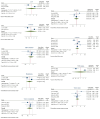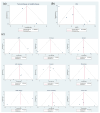Association of FOXO3 Expression with Tumor Pathogenesis, Prognosis and Clinicopathological Features in Hepatocellular Carcinoma: A Systematic Review with Meta-Analysis
- PMID: 34771514
- PMCID: PMC8582569
- DOI: 10.3390/cancers13215349
Association of FOXO3 Expression with Tumor Pathogenesis, Prognosis and Clinicopathological Features in Hepatocellular Carcinoma: A Systematic Review with Meta-Analysis
Erratum in
-
Correction: Fondevila et al. Association of FOXO3 Expression with Tumor Pathogenesis, Prognosis and Clinicopathological Features in Hepatocellular Carcinoma: A Systematic Review with Meta-Analysis. Cancers 2021, 13, 5349.Cancers (Basel). 2025 Jan 22;17(3):350. doi: 10.3390/cancers17030350. Cancers (Basel). 2025. PMID: 39895402 Free PMC article.
Abstract
Forkhead box O3 (FOXO3), an essential transcription factor related to liver disease, has been linked to cancer progression. The most frequent primary liver tumor, hepatocellular carcinoma (HCC), has an elevated mortality rate and patient outcomes remain very poor. Here, we examined the diagnostic, prognostic and clinicopathological significance of FOXO3 expression in HCC. We systematically searched Cochrane, Embase, PubMed, Scopus and Web of Science. Articles analyzing FOXO3 levels in HCC patient samples and its relationship with tumor development, survival or clinicopathological factors were selected. Hazard ratios, odds ratios and 95% confidence intervals were extracted, estimated by Parmar method or calculated and pooled across studies. Heterogeneity was evaluated by chi-square-based Q and I2 tests, while publication bias by funnel plots and Egger's test. Subgroup analysis was performed when heterogeneity was evident. The study protocol was registered in PROSPERO (CRD42021237321), and data were meta-analyzed employing STATA 16. Five studies involving 1059 HCC cases were finally included in this meta-analysis, finding that high FOXO3 levels significantly correlate with HCC development and shorter overall survival. Moreover, subgroup analysis revealed a significant association between positive FOXO3 expression and the risk of invasion. Thus, FOXO3 could function as a novel biomarker with diagnostic and prognostic value in HCC.
Keywords: clinicopathological features; diagnosis; forkhead box O3; hepatocellular carcinoma; prognosis.
Conflict of interest statement
The authors declare no conflict of interest.
Figures





References
Publication types
LinkOut - more resources
Full Text Sources
Research Materials

